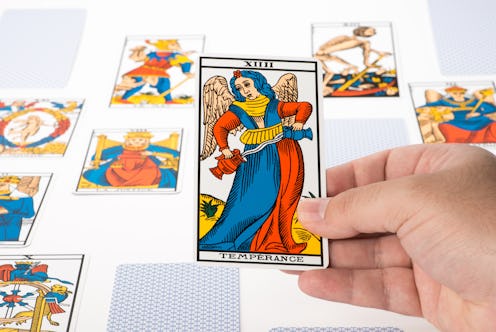Self
The Temperance Tarot Card Wants You To Connect With Yourself
It may be time for some R&R.

When you’re pulling tarot cards for yourself, some cards can make you feel a visceral reaction. For instance, the Death or the Devil card can immediately make you feel uneasy. The Lovers or the Wheel of Fortune, on the other hand, can make you more hopeful about the future. Then there’s the Temperance card, which in the traditional Rider-Waite tarot deck, features an angelic figure pouring liquid from one cup to the next. The image on the card alone can leave you feeling more puzzled than anything else. Fortunately, tarot readers share what it means when you pull the Temperance tarot card in a reading and how you can use that to manifest your future.
The tarot is made of 78 cards that are split into the major and minor arcana. Temperance is card number 14 in the major arcana and is sandwiched by the Death card (meaning transformation and change) and the Devil (which signifies obsessions, addictions, and a feeling of being chained down).
“While the Death card shakes everything up in someone’s life, the Temperance card is the next step,” Davida Rappaport, spiritual counselor and tarot reader tells Bustle. “It’s [meaning is] patience. It’s [about] watching your tongue so you don’t say anything that could get you into trouble or cause harm of any kind.”
Depending on the question being asked by the reader, the Temperance card could indicate a person’s need to exercise patience and understand that certain things take time. “The cards next to it are good modifiers and can explain what’s going on and why Temperance is needed,” Rappaport says.
Every card can be interpreted in a way that fits your specific situation, and every professional reader will have a unique way of seeing a card. However, it’s still a good idea to be familiar with the general meaning behind each card before getting a tarot reading. With that said, here’s what you need to know about the Temperance tarot card, according to readers.
What Does The Temperance Tarot Card Mean?
Temperance means balance. “It represents the harmony we experience in [our]self as we become more connected with who we want to be on the inside and who we must be on the outside,” RaDonna Reed, tarot reader and teacher, tells Bustle. “It can suggest a period of unity and alliance in self, or can encourage a period of disciplined peace.”
The Temperance card may show up after a period of chaos or significant change. If that’s the case, it may indicate a time of solace or respite, Reed says.
What Does The Temperance Card Mean When It’s Upright?
When the Temperance card is pulled upright, you’ll finally have some room to breathe. According to Reed, Temperance upright can be a card of relief. “It means one has made it through the messiness of the experience and can experience enlightened understanding if paying enough attention,” she says.
If an upright Temperance card is pulled in your tarot reading, it’s the perfect time to practice self-care, rest, and “soak” in the calm. Reed recommends using this time to reflect on the chaotic experience you just went through. “Rest is powerful here,” she says. “Just relax. I would recommend spending time in nature, making rituals out of routines, and finding any reason for rest to be legitimate.”
What Does The Temperance Card Reversed Mean?
When pulled in reverse, Temperance could mean resistance. According to Reed, you may be resisting time for rest and relaxation, and choosing to jump right into another situation rather than taking a beat. For instance, you might pull the Temperance card in reverse if you just broke up with a long-term partner and are now wondering about someone you just started talking to. In this case, the card may be telling you to take some time to yourself before committing to a new relationship.
“Patterns may repeat if not careful, and time to relax, decompress, or work through the hard feelings may be necessary,” Reed says.
Sources
RaDonna Reed, tarot reader and teacher
Davida Rappaport, spiritual counselor and tarot reader
This article was originally published on